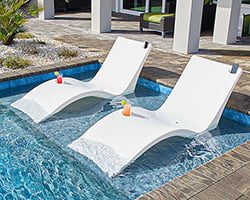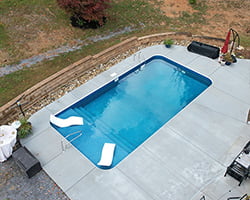Vinyl Inground Pool Liner Measurement Tips
The following is an introduction on how to measure a vinyl inground pool liner. Measuring standard pool shapes such as rectangle, Grecian, and oval pools will be discussed below. Free form shapes such as kidney, lagoon, or any pool shape featuring unique features should use the A-B triangulation method. This method can be used to measure any pool shape, but is primarily targeted at measuring freeform pools.
If you are already familiar with how to measure swimming pools using the A-B triangulation method, then the order in which you take the measurements may be slightly different then what you are used to, but overall the process is the same.
If you are new to measuring vinyl inground pool liners, this guide will help you through the various steps required and help prevent you from making common measuring mistakes that could result in a poorly fitting liner.
Measuring Your Swimming Pool
The following are some basic instructions for measuring a swimming pool for a vinyl inground pool liner. On our website you will find the appropriate form needed to record your pool measurements. If you haven’t measured a pool before, and you need some clarification regarding the order/measuring form, don’t hesitate to give us a call or your fabricator for any special instructions and helpful hints that they may have to offer.
A-B Triangulation Method
To begin measuring a pool, you will first need to place your A and B reference pegs.
It is important that the A and B pegs be placed such that there is a minimum distance of 10′ 0″ between them and, if you were to draw a straight line between them and extend it past both sides of the A and B pegs, that this A-B line does not cross any part of the pool.
If possible, the A-B line should be at least 3′ away from the closest point of the pool or any pool feature or obstacle that you will be measuring. If you are measuring for a replacement safety pool cover, the A-B line should be at least 3′ away from the existing anchor locations. You will not be able to correctly measure the pool if the A-B line crosses any part of the swimming pool.
It is important that for accurate measurements, whatever you use for your A and B pegs, they remain perfectly stationary and will not move. If one of the pegs moves during the measuring process, you will need to set up your A and B pegs again and start your measurements all over again.
Carefully measure the distance between the A and B pegs. This measurement needs to be as accurate as possible. Record this measurement on the Free Form measurement form as the A-B Length input.
When looking at a plot of the pool, we assume that the A and B pegs are placed at the “bottom” of the pool plot and requires that the A peg to be on the left and the B peg on the right. This means that if you were to stand between the A and B pegs and face the swimming pool, the A peg would be to your left and the B peg would be to your right.

You will not be able to correctly measure the pool if the A-B line corsses any part of the pool.
Marking Your Points
Using a piece of chalk or other temporary mark, walk around the pool and mark your measuring points around the edge of the swimming pool.
Start by marking the most important points first and then come back and fill in additional points as required. It is recommended that you mark these points in one color and the fill-in points in another. This will help identify these points when you start taking your measurements.
The following are examples of some of the important points that should be marked first. There may be others depending on the style of pool being measured.
- Mark each side of the steps.
- For a liner, mark where the break lines extend to the perimeter of the pool.
- Mark any location where the radius of a corner or arc changes.
- Mark the ends of any straight edges.
- For a safety cover, mark where any water features that will interfere with the cover.
- Mark the points that will later be used for length and width cross pool measurements.
Then go back and add in any required points between these marks. You should have a point, on average, every 2 to 3 feet around the pool for smooth and consistent curves. For sharp curves, you may need to place points even closer – at 1 to 2 foot intervals or even closer. For straight edges, one point between the two end points may be sufficient.

Measuring Rectangular & Straight Wall Inground Pool Kits
For swimming pools that are rectangular or otherwise constructed with straight pool walls, you can avoid taking numerous measurements around the curved corners of the pool.

Do this by measuring from the point where the straight pool walls would intersect on your deck or patio to the place where the wall begins to curve, note the corner radius on the liner measurement form. The diagram illustrates where to place the point and how to take the radius measurement.
Note that the radius measurement matches the length of the sides of the square shown above over the corner. Use this same reference point to measure the width and length of the pool, in other words measure the width and length of the pool as though it has square corners. Measuring depths and floor dimensions is detailed below.
Swimming Pool Perimeter
If measuring for a liner, measure the perimeter of the swimming pool. The measurement should be taken at the location of the pool wall. See the illustration below to identify the location of the pool wall. Lay your tape measure on your deck above the location of your pool wall and measure around the entire perimeter of the pool.
You only need to measure along the top of the pool liner. For example, if the pool has fiberglass steps, do not include the steps in the perimeter measurement – just measure across the front of the steps where the liner goes.
Taking Your A and B Point Measurements
The A and B measurements will accurately identify the shape and size of your pool. To take your measurements, it is recommended that you have two identical fabric/fiberglass (non-metalic) measuring tapes. Fasten the end of one tape measure to the A peg and the other to the B peg.

When taking your measurements, it is important that you measure to the correct location. The measurement is from the A or B peg to the pool wall. See the illustration above to help identify the location of the pool wall.
Starting at one side of the steps and working clockwise around the swimming pool, take measurements from the A and B pegs and record the measurements. Check with your supplier, but typically, your measurements should be accurate to the nearest 1/4 inch or 5 mm for liners and 1/2 inch or 10 mm for covers.
Break Lines
If measuring for a liner, add and note break line points for the break lines in the pool. Measure the points on the perimeter of the pool where the break line would cross the perimeter. A break line is a straight line across the pool floor where the flat part of the shallow or deep end stops and the slope to the other begins.
Wall Height and Deep End Depth
Measure the wall height for the vinyl inground pool liner. The wall height is measured from the bead receiver to the bottom of the wall. See the following illustration for the pool wall height measurement.

The deep end depth is also measured relative to the bead receiver, but is taken from the deepest portion of the swimming pool. Again, see the following illustration for deep end depth measurement.
Deep End Slopes
For a vinyl inground pool liner to fit the deep end properly, it is important that the deep end slope measurements be taken correctly.
These measurements are the horizontal distance from the pool wall to the bottom end of the slope. It is not the measurement along the slope.
The following illustrations show how to take the slope measurements. Note that a pool with a hopper type deep end as illustrated, will have three measurements that will add up to the width of the pool and four measurements that will add up to the length of the pool.
For a hopper style deep end, three slope measurements are required as shown in the following illustration. One measurement is required for each end of the deep end break line and the third measurement is taken at the end of the deep end. A similar measurement will be taken for the long transitional slope between the shallow end and deep end. Again, these are horizontal measurements.

Make sure to give us a call with any questions you have about ordering a vinyl inground pool liner. Our liner pros have years of experience and can answer almost any question you might have!
All Images & Content © PoolWarehouse.com
At Pool Warehouse, We Know Vinyl Inground Swimming Pool Liners!








 What are our customers saying?
What are our customers saying?

